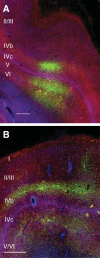Strategies for targeting primate neural circuits with viral vectors
- PMID: 27052579
- PMCID: PMC4961743
- DOI: 10.1152/jn.00087.2016
Strategies for targeting primate neural circuits with viral vectors
Abstract
Understanding how the brain works requires understanding how different types of neurons contribute to circuit function and organism behavior. Progress on this front has been accelerated by optogenetics and chemogenetics, which provide an unprecedented level of control over distinct neuronal types in small animals. In primates, however, targeting specific types of neurons with these tools remains challenging. In this review, we discuss existing and emerging strategies for directing genetic manipulations to targeted neurons in the adult primate central nervous system. We review the literature on viral vectors for gene delivery to neurons, focusing on adeno-associated viral vectors and lentiviral vectors, their tropism for different cell types, and prospects for new variants with improved efficacy and selectivity. We discuss two projection targeting approaches for probing neural circuits: anterograde projection targeting and retrograde transport of viral vectors. We conclude with an analysis of cell type-specific promoters and other nucleotide sequences that can be used in viral vectors to target neuronal types at the transcriptional level.
Keywords: gene therapy; optogenetics; primate; targeting; viral vector.
Copyright © 2016 the American Physiological Society.
Figures



References
-
- Aartsen WM, van Cleef KW, Pellissier LP, Hoek RM, Vos RM, Blits B, Ehlert EM, Balaggan KS, Ali RR, Verhaagen J, Wijnholds J. GFAP-driven GFP expression in activated mouse Müller glial cells aligning retinal blood vessels following intravitreal injection of AAV2/6 vectors. PLoS One 5: e12387, 2010. - PMC - PubMed
-
- Abbott NJ. Evidence for bulk flow of brain interstitial fluid: significance for physiology and pathology. Neurochem Int 45: 545–552, 2004. - PubMed
-
- Alexander IE, Russell DW, Miller AD. Transfer of contaminants in adeno-associated virus vector stocks can mimic transduction and lead to artifactual results. Hum Gene Ther 8: 1911–1920, 1997. - PubMed
-
- Arnold CD, Gerlach D, Stelzer C, Boryn LM, Rath M, Stark A. Genome-wide quantitative enhancer activity maps identified by STARR-seq. Science 339: 1074–1077, 2013. - PubMed
Publication types
MeSH terms
Grants and funding
LinkOut - more resources
Full Text Sources
Other Literature Sources

